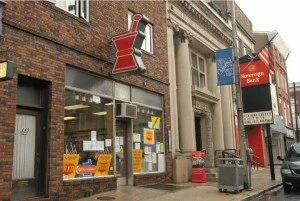One of the biggest advantages of shopping for prescription drugs online is price transparency, which empowers the consumer to easily find the best price among available options.
As healthcare consumers well know, it is very difficult to comparison shop among brick-and-mortar pharmacies, because pharmacies typically don’t advertise their prices for prescription drugs (with the exception of the Wal-Mart generic drug program and similar programs, which generally include a list of covered drugs on the retailer’s Web site.)
Because it’s difficult to compare prices, particularly for expensive, brand-name drugs, most consumers buy at their corner drugstore, assuming the price isn’t much different from the next corner — or the other side of town. This simply isn’t the case. What’s worse, the disparities in pricing disproportionately affect poorer people.
According to a new study appearing in the Health Services Research journal:
Four of the most widely prescribed drugs in the United States can cost 15 percent more on average in the poorest neighborhoods of Florida, according to a study comparing retail pharmacy prices around the state. Part of the explanation is the high proportion of independent pharmacies in poor ZIP codes that charge the highest prices for Nexium, Advair, Plavix and azithromycin…
In contrast, the study shows that chain pharmacies are less expensive and less likely to vary their prices based on ZIP code. However, they are also less common in poorer areas. The authors noted that some independent pharmacies in poor neighborhoods did charge prices similar to chain pharmacies, but that issues such as health literacy, finances and transportation could limit consumers from shopping around…
Even small price increases have negative consequences, and two earlier studies found that the cost of prescription drugs discourages uninsured and poor people from filling their prescriptions. As a result of not controlling their health, they spend more time in emergency rooms.
The researcher behind the study concludes:
“Insuring the uninsured is a priority. However, uninsured people who pay retail prices for their medications and struggle with health care costs should not face higher prices because of where they live. Even though these variations are based on data from only one state, they deserve further investigation.â€







One Response to Study: Prescription drugs cost more in poor neighborhoods
Leave a Reply Cancel reply
-
-
Search Blog Posts
-
Save Even More Money!
-

-
Trending Content
-
Watch our YouTube Video
-
Categories
Big Pharma Buy prescriptions online Canadian drugs Drug costs Drug reimportation Drug safety eDrugSearch.com FDA Health 2.0 Healthcare100 Healthcare blogs Healthcare solutions Low-cost drugs Medicare Part D Merck Online pharmacies Online pharmacy safety Pfizer Pharma bloggers Pharmaceutical companies Pharmaceutical marketing Pharma cheerleaders Prescription drug abuse Prescription drug prices Prescription drugs Prescriptions Wal-Mart drug plan -
Blogroll
- Bullet Wisdom
- Bulverde Business Directory
- Christian Counseling San Antonio Tx.
- Christian Schools in San Antonio Texas
- Christian Social Network
- Christians United for Israel
- DrugWonks.com
- Eye on FDA
- GoozNews
- Health 2.0
- Hunting Forum
- In the Pipeline
- Jesus Christ Our King
- John Hagee Ministries
- Kevin, M.D.
- Local Search Marketing
- My $299 Website
- Pharm Aid
- Pharma Marketing
- PharmaGossip
- Pharmalot
- San Antonio Asphalt
- San Antonio Life Insurance
- San Antonio Pressure Washing
- Storage New Braunfels Tx
- Texas Wildlife Supply
- The Angry Pharmacist
- The Health Care Blog
- The Peter Rost Blog
- World Vision
-
Tags
big pharma Canadian drugs canadian pharmacies canadian pharmacy consumer reports craig newmark divine healing Drug costs drug prices Drug reimportation eDrugSearch.com FDA Fosamax Generic drugs healing scriptures Health 2.0 healthcare reform Hypertension Jehova Rophe Jesus Christ Lipitor Metformin miracles nabp online pharmacy dictionary online prescriptions osteoporosis peter rost Pharmacies pharmacists pharmacychecker pharmacy spam phrma Prescription drugs prescription medication Proverbs 3:5-8 reimportation relenza Roche saving money SSRI swine flu Tamiflu The Great Physician The Lord our Healer -
Recent Tweets
- eDrugSearch Blog Rank on the Healthcare100: http://t.co/VJprL4LZWl [#]
- New blog posting, How to Get Prescription Medication Without Health Insurance - http://t.co/1ZdLavB87d [#]
- 10 Tips for Safer Prescription Drug Use http://t.co/GFnMIN1mCy [#]
- New blog posting, How to Beat High Drug Prices By Comparing Low Cost Pharmacies - http://t.co/fsZ0stNZme [#]
-
Archives
-
Recent Comments
- Heather Sturges on What is the Difference Between Effexor and Cymbalta?
- Lupe Machol on Cost of diabetes drugs has nearly doubled
- Manpower For Hospital In Pune on Why is Medicine Cheaper in Canada?
- Jen on How a Canadian Pharmacy Can Help You Offset Drug Price Hikes
- nino iarajuli on Vending machine dispenses prescription drugs

I got my birth control prescription filled at three different Walgreens pharmacies and the price was different every time. When I asked the pharmacist about it, I was told that the prices were “based on the market”.